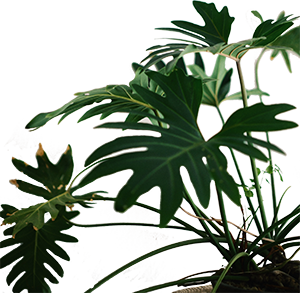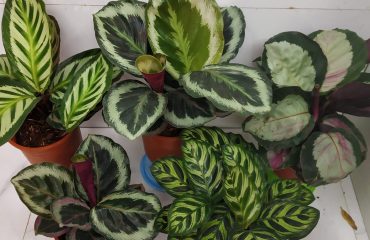Different Types of Indoor and Outdoor Ferns with Pictures
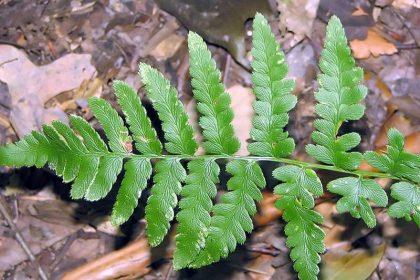
Ferns are one of the oldest types of plants in existence, dating back over 350 million years. They are one of the most popular types of plants used for shaded areas, as they thrive in low light conditions, bringing much-needed greenery and life to dark and dull corners of both gardens and homes.
Ferns do not produce flowers and instead are prized for their fronds, which delicately unfurl to reveal unusual and attractive plants. They cannot be propagated from seed or stem cuttings, instead, reproduce from spores on their foliage. Ferns sometimes find themselves with a bad reputation of being tricky to care for, and it’s true that many people struggle to keep ferns thriving, but this is more commonly down to people not understanding their care requirements.
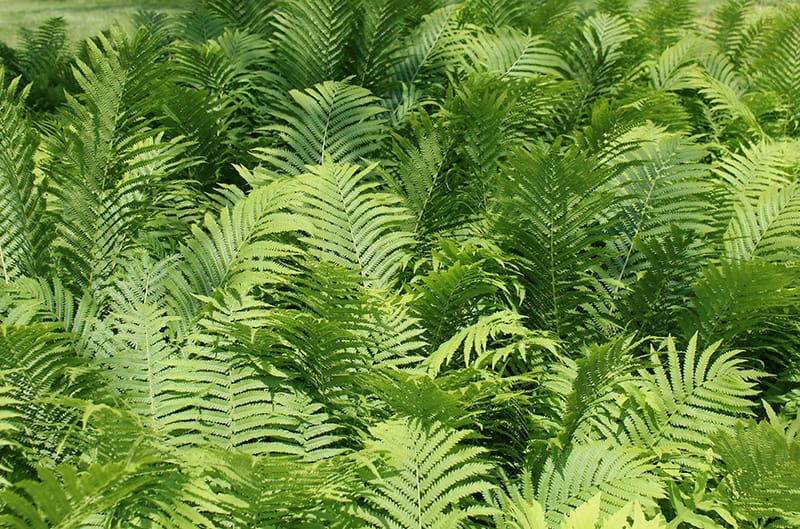
Once you understand the needs of ferns, they are actually very easy to care for and have so much to offer. They typically like to grow in moist conditions with high humidity, and these are two areas that some people struggle with, especially those who like to have plants they can occasionally water but otherwise forget about.
If you aren’t available for misting your plants on a daily basis, then ferns might not be for you, although you could consider investing in a humidifier instead. Always ensure your ferns are growing in well-draining soil to allow excess water to drain away from the plant’s roots. Though they like moist soil, they typically don’t like wet soil (though there are some exceptions to this). Therefore, a well-draining soil should help resolve any overwatering issues.TABLE OF CONTENTS
Best Indoor Ferns
Boston Fern (Nephrolepis exaltata)
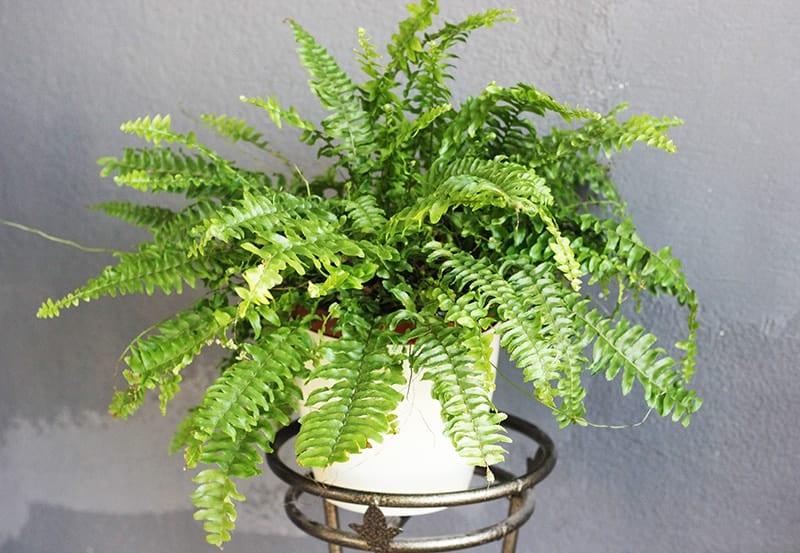
The Boston fern, also known as sword fern, is one of the most popular ferns to be kept as a houseplant. It requires warm conditions, only being hardy in USDA zones 9 to 11 when kept outside. This makes it ideal for use as a houseplant, as temperatures in homes tend to be perfect for this plant.
Boston ferns have something of a reputation for being difficult to keep alive; in fact, it is very easy to care for this plant as long as you know what it needs. Boston ferns need bright but indirect sunlight. They aren’t well suited to a spot on a sunny windowsill; instead, keep them out of direct light by placing them on a table in a bright room.
They require high humidity and consistently moist soil to thrive. Humidity in homes is generally low, but you can increase this by using a pebble tray, a humidifier, or by giving you plant a daily water mist spray. The most common reason that Boston ferns die is due to their soil being allowed to dry out. You will need to maintain evenly moist soil to keep this plant happy. However, it will not do well in soggy soil.
Ensure it is planted in well-draining soil to allow any excess water to pass through the soil and out of the pot’s drainage holes. Water the plant again once the top of the soil is starting to dry out. Also, refrain from using much fertilizer, if any at all, as this plant is sensitive to this.
Staghorn Fern (Platycerium spp.)
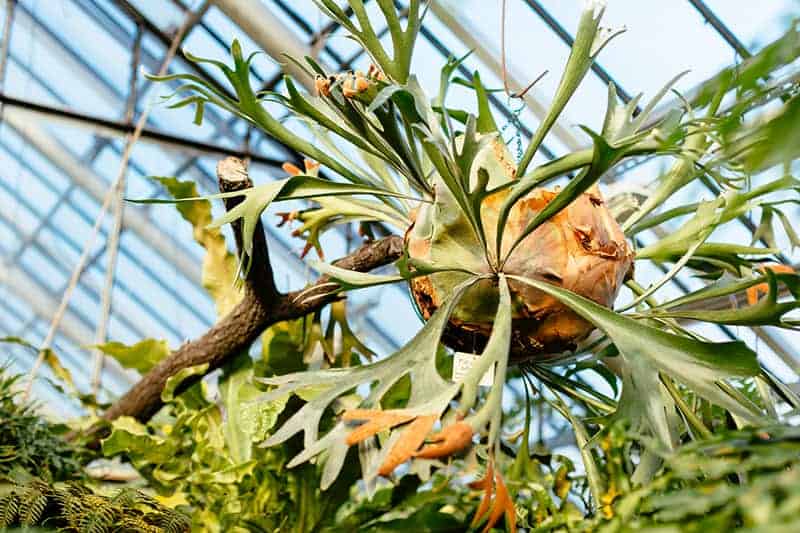
These ferns are epiphytes, which means that they do not grow rooted in soil. Instead, they grow on other plants or trees in their native habitats. Staghorn ferns are most commonly grown mounted on wood in the style of antlers, as the unusual foliage bears a resemblance to those of the staghorn.
These unique ferns are often looked upon as living art rather than as houseplants. They require medium or low light and high humidity. Indoors, position the staghorn fern in a spot that gets plenty of bright but indirect light, while if kept outdoors. it can be situated in the shade.
Only water the plant moderately, and give it a regular misting to increase the moisture content of the air around the plant. They typically reach about 3 feet in height and 2 feet in width and can last for many years to be passed down the family as heirlooms.
Kangaroo Paw Fern (Microsorum diversifolium)
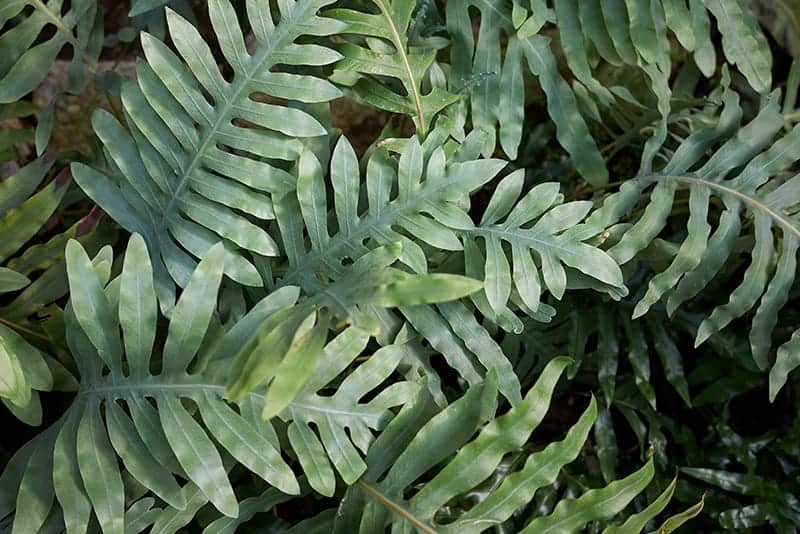
As you might expect from the name, this plant is a native of Australia. ‘Kangaroo paw’ refers to the long fronds of the fern, which resemble the oversized feet of the kangaroo.
This plant likes very warm climates, and so for most people, it is suitable only to be grown as a houseplant. If you live in USDA hardiness zones 9-12, it can be grown outdoors, or if you’re outside these zones, you could move it outside for the summer months where it is best kept in partial shade.
The kangaroo paw fern is an interesting plant; it can be epiphytic, growing in crevices of rocks or on tree trunks, but it can also be grown in soil. The foliage of the plant is not what you might expect from a fern. The fronds have a glossy, leathery texture and can be smooth or have notches around the edge. The foliage is a deep shade of green, and the fronds themselves can come in a variety of shapes and sizes.
To grow this fern as a houseplant, position it in indirect light. If you have a partially shaded corner of your home, you could also try growing this fern there as it can do well in some shade.
As with most ferns, this plant enjoys high humidity, so mist it daily or use a pebble tray, or grow it in a naturally humid room such as a bathroom. The plant likes its soil to be kept consistently moist, but it does not like to be in soggy soil. Grow it in well-draining soil to allow any excess water to drain out of the plant, and aim to maintain a damp soil.
Crocodile Fern (Microsorium musifolium ‘Crocydyllus’)
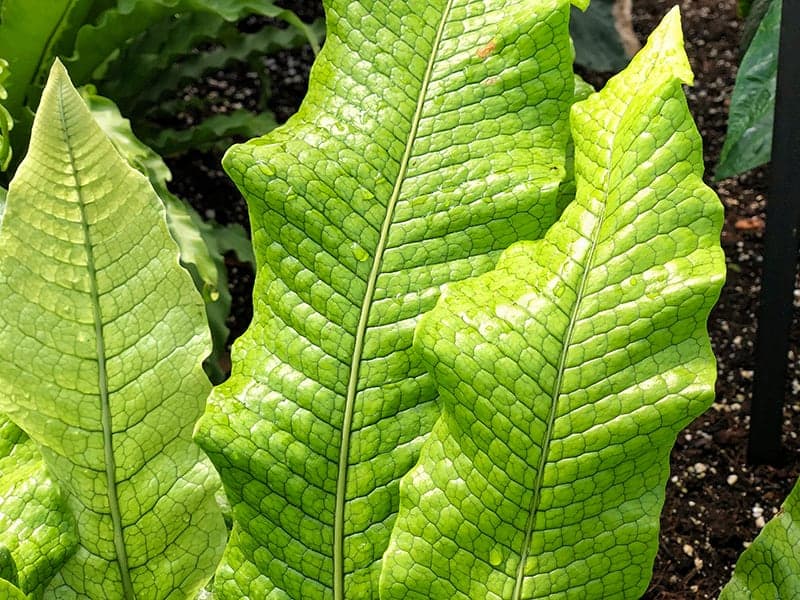
Another Australian native, this tropical fern, has mid-green leaves with dark green veining with an unusual texture that is said to resemble crocodile skin. Although the name suggests this plant might be quite tough, it actually is quite delicate in nature and in looks. It can survive only in warm temperatures and will die at the slightest hint of cold. For this reason, it is best kept as a houseplant away from cold drafts, cooling vents, or open windows.
The plant enjoys high humidity, so it is well suited to life in a bathroom. Otherwise, you will need to increase humidity by misting the plant or sitting it on a pebble tray. It likes to be grown in moist soil but is very unforgiving of soggy soil; for this reason, it should be grown in a growing medium with a high content of bark to allow water to drain through it easily.
Water the plant when the top of the soil is dry to the touch, but never allow the whole pot to dry out. The plant will scorch easily in direct light, so keep it away from window sills, and instead position it in indirect light or partial shade.
It is sensitive to fertilizer, and a feed that is too highly concentrated will kill the plant. Err on the side of caution and always heavily dilute the fertilizer, or if in doubt, forego fertilizer entirely.
Best Outdoor Ferns
Osmunda Ferns
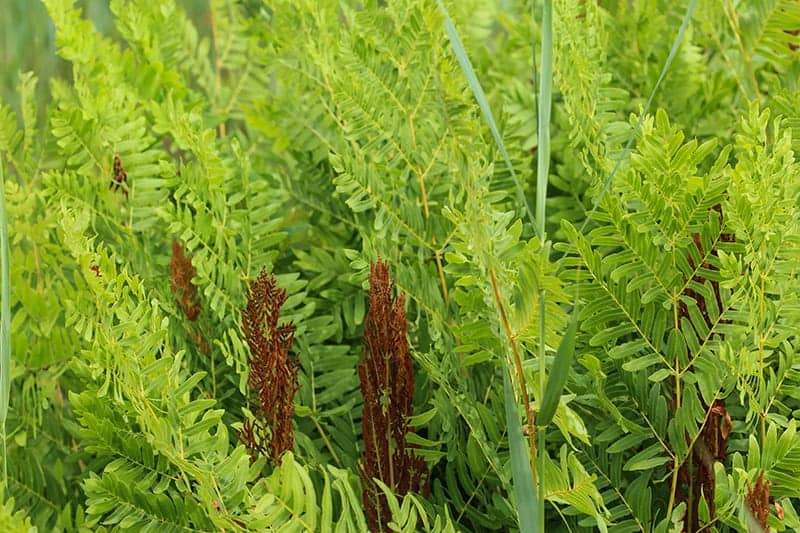
These moisture-loving ferns are native to the United States, found everywhere eastwards from the Mississippi River. They thrive in swamp-like conditions, growing naturally on the edge of riverbanks and in wet woodlands.
If you’re looking for a large fern to fill a boggy corner of your garden, then an osmunda fern would be a great choice, as they are among the tallest fern you can grow at home. Varieties of osmunda ferns include the following.
Cinnamon Fern (Osmunda cinnamomea)
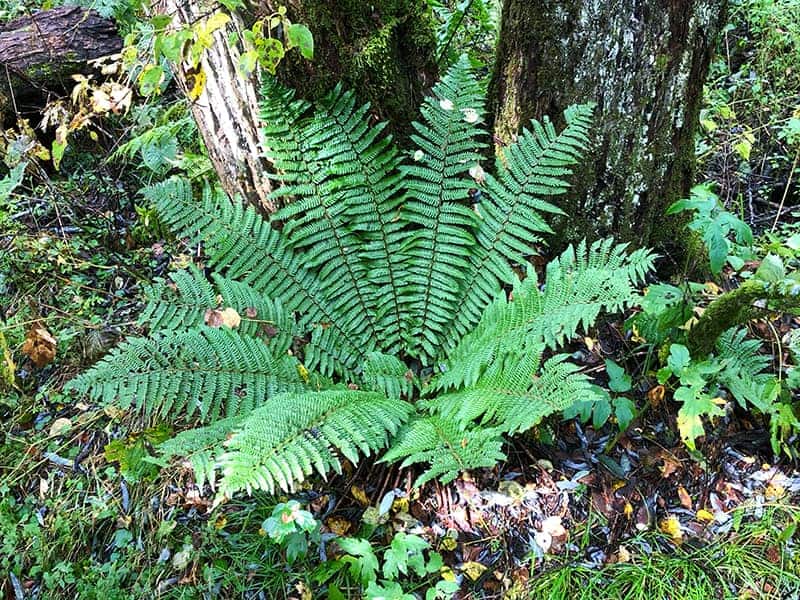
These ferns reach heights of 5 or 6 feet and feature two different colored fronds. In the center of the plant grow orange-brown upright fronds resembling plumes, which are laced with spores and reach lengths of 3 feet. It is these fronds that give the plant its common name, as they are similar in appearance to cinnamon sticks.
On the outer edge are pale green fronds, which can be double the size of the central fronds. The plant thrives in wet conditions and is well suited for planting on the edge of a pond or anywhere that will benefit from consistently moist soil.
This plant is best suited for planting in full or partial shade, though unusually for a fern, it can cope with long hours of direct sunlight, so long as it is grown in standing water. If you do plant the cinnamon fern in a well-lit spot, you can expect that it won’t reach its full height. The plant is hardy through USDA growing zones 4 to 9, making it suitable for growth in a wide range of climates.
Interrupted Fern (Osmunda claytoniana)

This large fern stands at a mature size of 6 feet wide and 3 feet tall, occupying a substantial amount of space in the home garden. It is deciduous, so its leaves will drop in the fall, which could leave quite a vast gap in your outdoor area.
The common name of this plant comes from its brown leaflets, which give the appearance of interrupting the green leaflets where they appear along the frond. This plant is hardy through USDA zones 3 to 6, and like other osmunda ferns, prefers to be grown in moist or wet soil.
Maidenhair Ferns
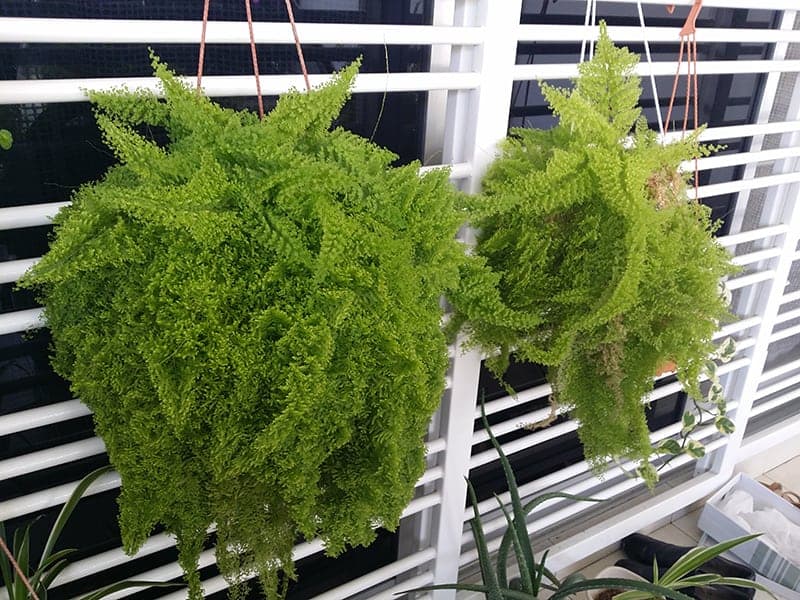
These delicate-looking ferns feature lots of small leaflets on compound leaves. They are varying shades of green and rely on constantly moist soil and high humidity to survive. To grow these plants in your garden, you’ll need to recreate the natural environment where these ferns grow natively, which namely involves ensuring your soil is high in rich organic matter.
These ferns will burn easily in direct sunlight, so they should always be planted in a shaded position, and if they are subjected to any light, it must be in the early morning when the sun is at its lowest intensity. There are several varieties of maidenhair ferns, including the houseplant Adiantum raddianum, but the following varieties are suitable for growing outdoors.
American Maidenhair Fern (Adiantum pedatum)
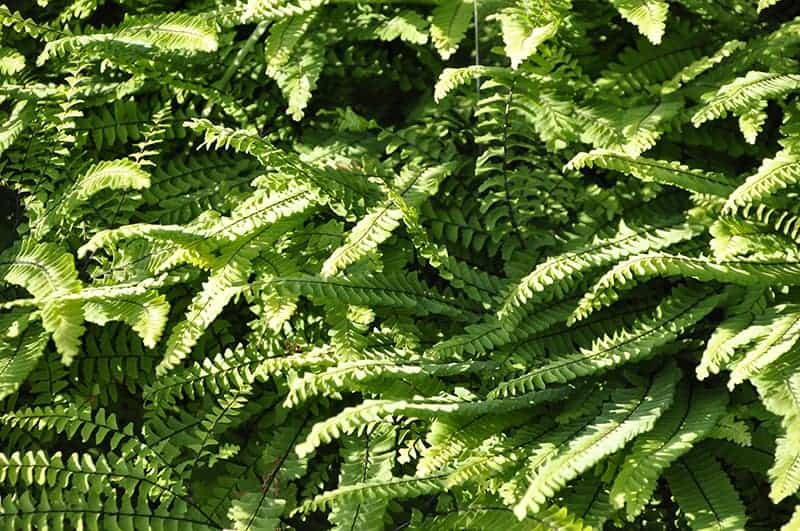
This fern is native to North America and is hardy through USDA growing zones 3 to 8. It grows to a maximum height of 16 inches and features dark brown or black stalks from which dainty feathered leaves grow. Plant it in a shaded corner of your garden where it will thrive in moist conditions. This plant also works well as a groundcover or in containers.
Northern Maidenhair Fern (Adiantum pedatum aleuticum)

This plant is similar in looks to the American maidenhair fern but grows to about twice the height, standing at 30 inches tall. Its stems are a deep purple-black, standing out nicely against the delicate green foliage. Several cultivars of this fern variety exist, including ‘Japonicum,’ which produces new growth that is tinged with pink and ‘Miss Sharples,’ which has new growth in a pale yellow-green shade.
Northern maidenhair ferns are hardy through USDA growing zones 4 to 8
Southern Maidenhair Fern (Adiantum capillus-venerus)
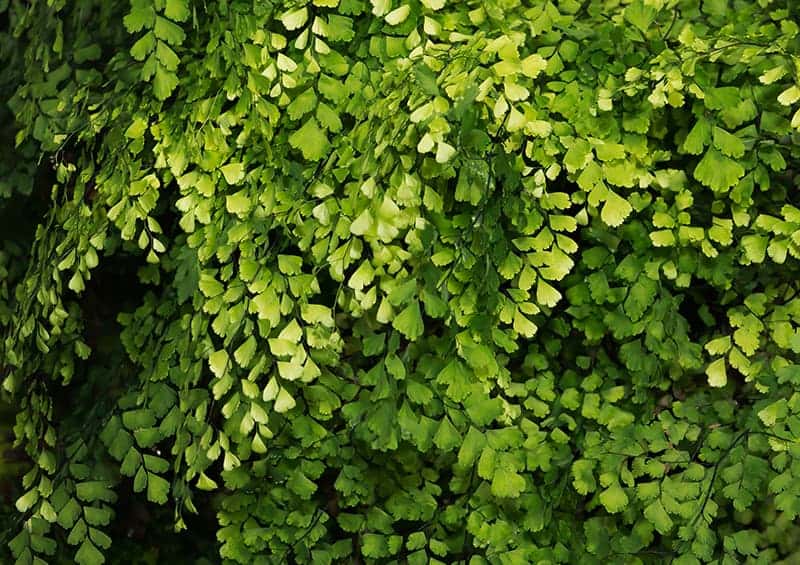
This delicate-looking plant is more robust than it appears, but it thrives in heat and high humidity. It is suitable only for growing outdoors in USDA hardiness zones 8 to 10, where winter temperatures do not drop too low.
The plant is evergreen down to 28 ºF, and though it enjoys being kept warm, it does not like direct sunlight, as its leaves will easily scorch. Keep it in the shade and ensure its soil is rich and kept consistently moist without being waterlogged.
Lady Ferns
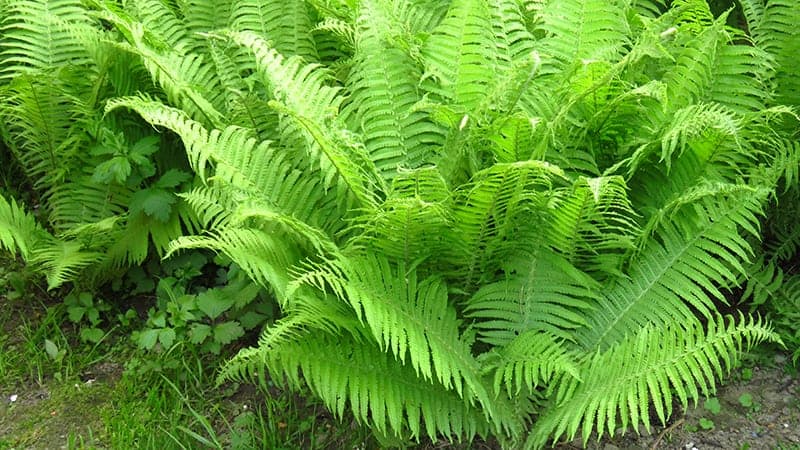
As their name suggests, lady ferns are elegant and beautiful. There are many varieties of fern that fall into the category of lady fern, somewhere in excess of 160 different species.
Lady ferns, like most ferns, thrive in shade and moist soil. They are native to woodland areas where the soil is humus-rich and sometimes boggy, protected from the sun by an overhead canopy of larger plants and trees. While it is true that these ferns prefer to be kept in moist conditions, they are actually fairly drought-tolerant once mature. Types of lady ferns include the following.
Japanese Painted Fern (Athyrium niponicum pictum)
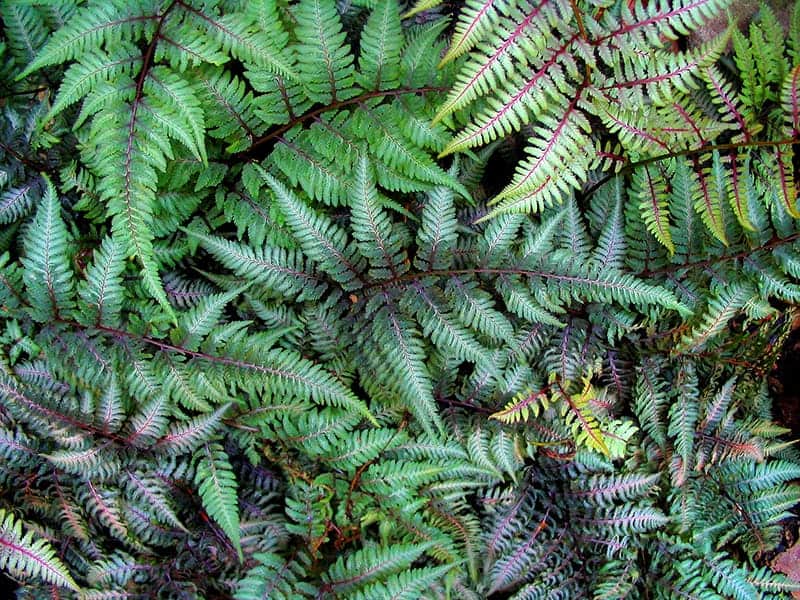
This plant has a very unusual look for a fern, which is typically green. Japanese painted ferns, however, have burgundy stems with silver foliage, which looks as though it has been brushed with dashes of red and blue. This plant is truly beautiful, offering up a work of art in your garden.
It grows up to 2 feet wide and 3 feet high and is surprisingly hardy. It is suitable for growing in USDA hardiness zones 4 through 8 and can survive periods of drought once established. Unlike most ferns, which appreciate full shade, this plant can adapt to partially sunny conditions, though always avoid afternoon sun to prevent the pretty foliage from scorching
Tatting Fern (Athyrium filix-femina ‘Frizelliae’)
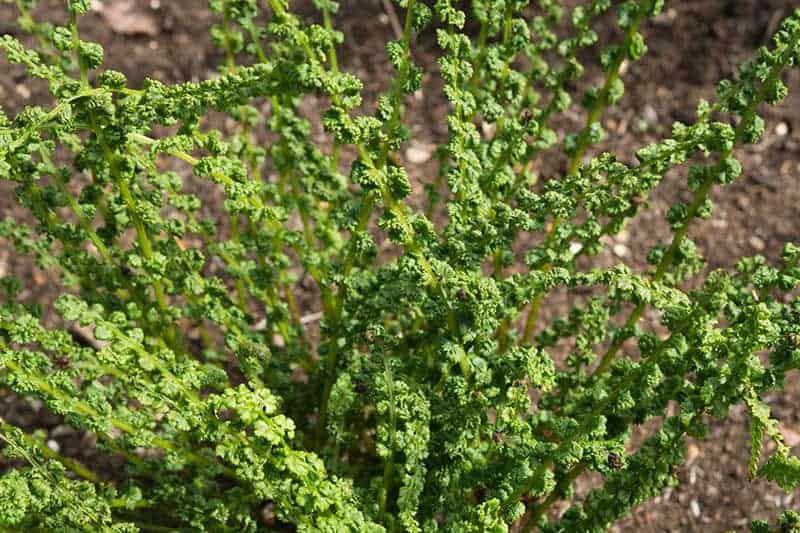
If you’re looking for a very unusual fern, then this could be the one. Spherical balls of leaflets are dotted along chunky pale green stems, giving the appearance of lacy beads on a string. This plant is a dwarf variety, growing to just one foot in height. Despite its delicate appearance, it is quite hardy, growing happily in USDA zones 4 through 8.
Lady in Red Fern (Athyrium filix-femina ‘Lady in Red’)
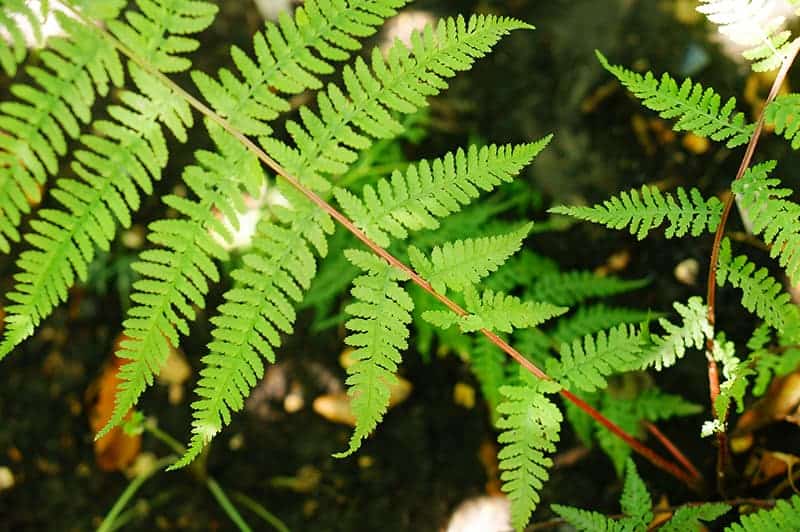
This fern has a vigorous vertical habit, growing upright to heights of up to 24 inches and 3 feet in width. Its name comes from its bright red stems, which are laced with pale green feathery foliage. It is hardy through USDA growing zones 3 to 8 and is considerably more drought-tolerant than most ferns.
While it will happily grow in moist soil, it can also survive periods of drought without sustaining any damage, though if in doubt, err on the side of caution and offer it up some water in dry seasons.
Silver Falls Japanese Painted Fern (Athyrium niponicum ‘Silver Falls’)
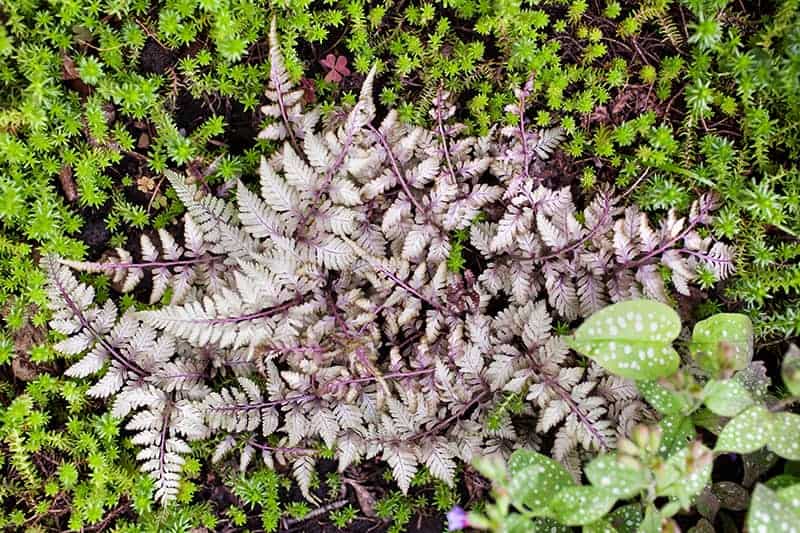
Unlike most ferns, this plant actually benefits from a few hours of sun each day. Plant it in a position of partial shade, where it can receive a few hours of the morning sun and then be protected from sunlight during the hottest part of the day.
Though it is more tolerant of direct light than other ferns, it is still susceptible to scorched foliage and should be kept out of the sun when it is at its most intense in the afternoon. With a few hours of morning sun each day, this plant will be able to best showcase its pink stems and purple veins. It is hardy through USDA growing zones 5 to 8.
Ostrich Fern (Matteuccia struthiopteris)
This large fern produces majestic fronds that can unfurl to up to 5 feet in length, giving the plant a wild vase shape. If you have a generous space in a shaded corner to fill, then this plant could be for you, though steer clear of it if you like to keep things neat and tidy because it does have a habit to get a little unruly and will takeover any nearby plants you are growing. This fern likes to have space to spread out, typically reaching about 3 feet in height and 3 feet in width, though it can be bigger.
It gets its common name from the upright soft feathery fronds that resemble ostrich tail feathers. Like most ferns, it enjoys moist, rich soil and does best in a position of shade. The ostrich fern is able to tolerate some sun but only if its soil is kept adequately moist. An ostrich fern in dry soil will be unable to cope with direct sun and will suffer from scorched leaves.
It is fairly cold hardy, suitable for growing in USDA hardiness zones 3 to 8.
Wood Ferns
If you love the look of ferns but aren’t sure if you can handle how particular these plants are about their growing conditions, then wood ferns might be a good choice for you as they are much more adaptable than most other types of ferns.
They tend to be of a medium-size, which makes them suitable for planting in most gardens, and they are exceptionally tough for ferns. They will be drought-tolerant once mature and can be grown in numerous lighting conditions, from full shade to indirect light. Some wood ferns are evergreen, while others are deciduous.
Types of wood fern include the following.
Leatherleaf Fern (Rumohra adiantiformis)
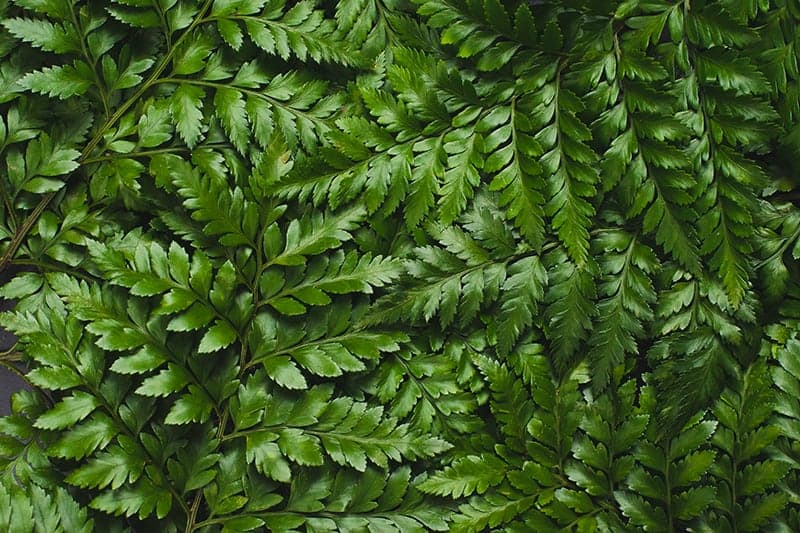
This fern gets its name from its glossy green leaves, which have a leathery texture. It likes to be kept in moist but not wet conditions, and so, relies on a well-draining soil to thrive. It grows to around 3 feet in height, with a similar width and does well in either full shade or partial shade. It prefers warmer conditions as it is native to the southern hemisphere, and is hardy through USDA growing zones 8 to 11.
Autumn Fern (Dryopteris erythrosora)
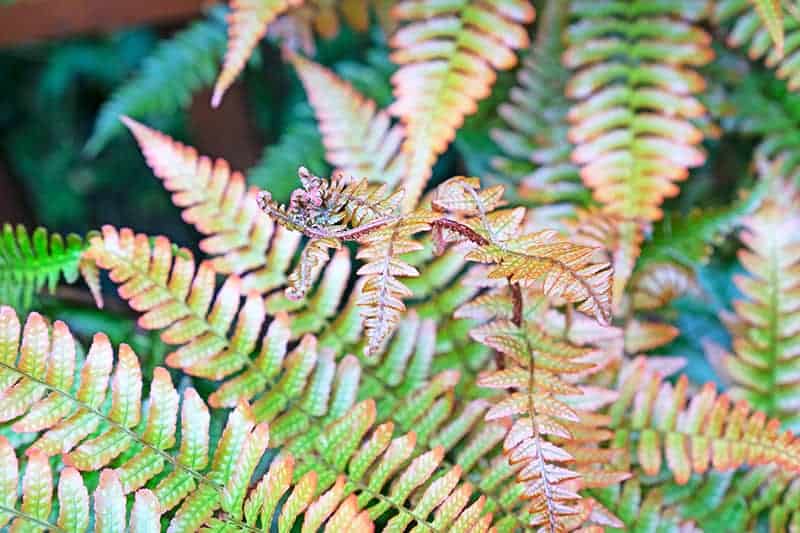
It’s not hard to see where this fern got its common name, with its stunning copper-red foliage that develops into gold and green as the seasons pass, eventually turning to rust in fall. The plant will be evergreen in warmer climates and deciduous in areas that experience frost.
It is hardy through USDA growing zones 5 to 9 and has an expected size of 2 feet high and 2 feet wide. Different cultivars of this plant are available, some of which produce even more vivid foliage colors.
Marginal Wood Fern (Dryopteris marginalis)
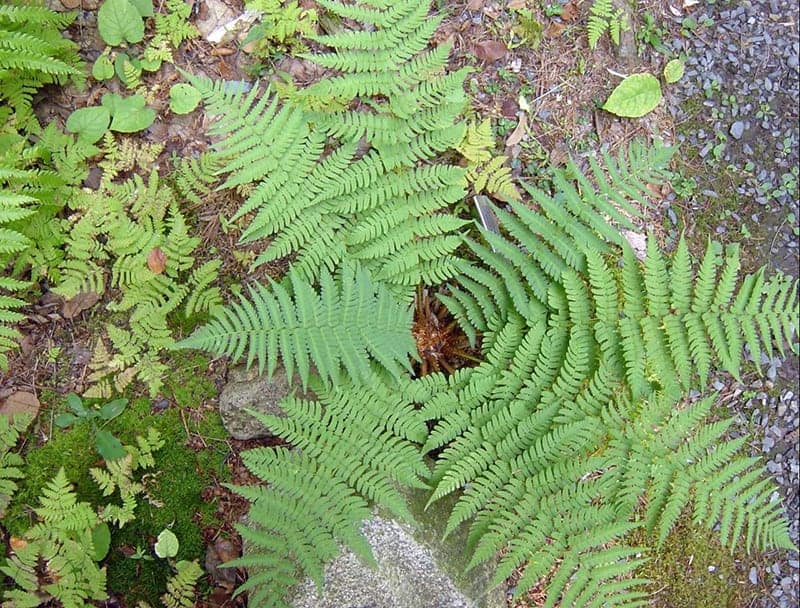
This fern is wider than it is tall, making it a useful ground cover under trees. It grows happily in the shade and requires moist soil high in organic content.



